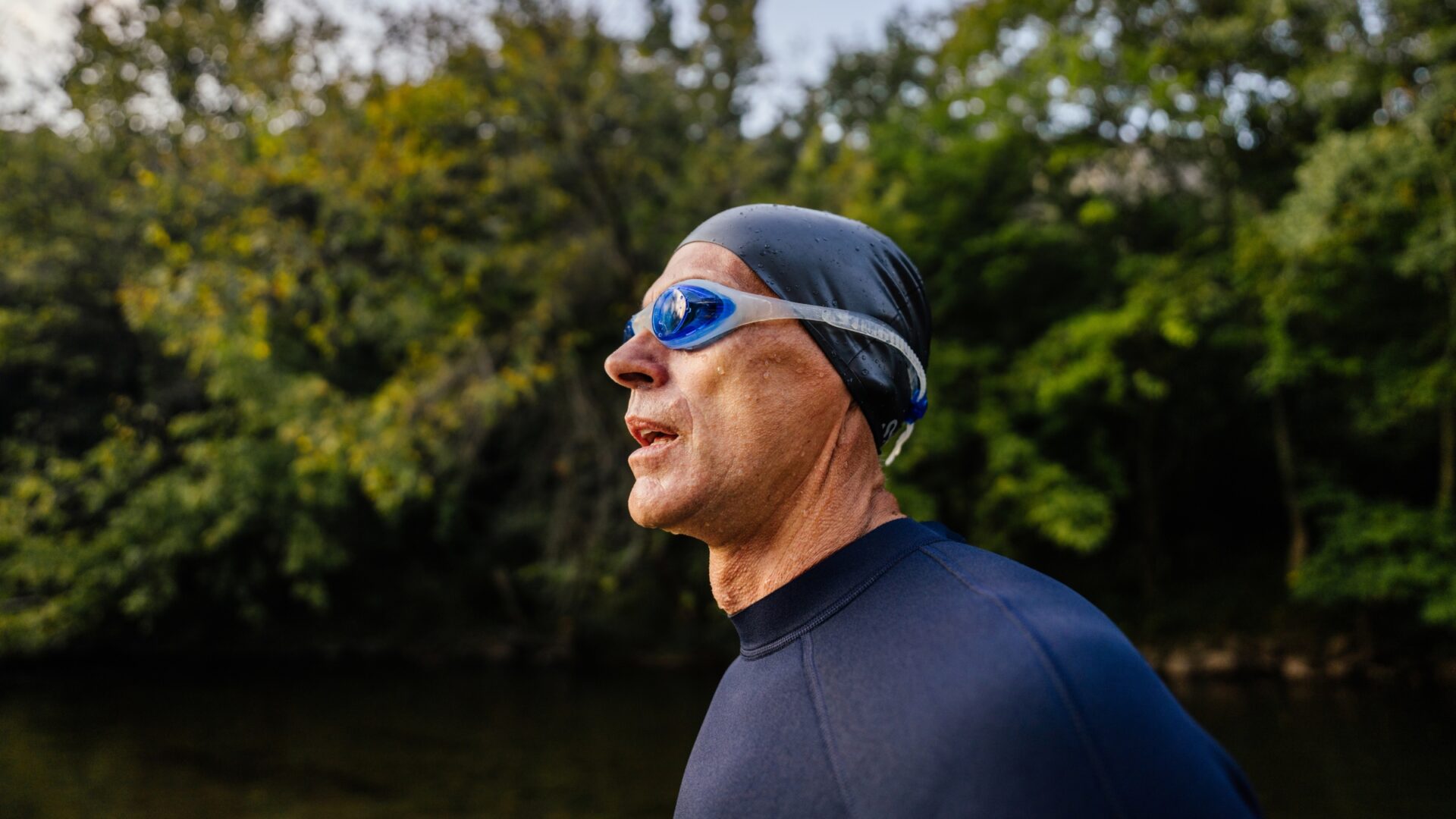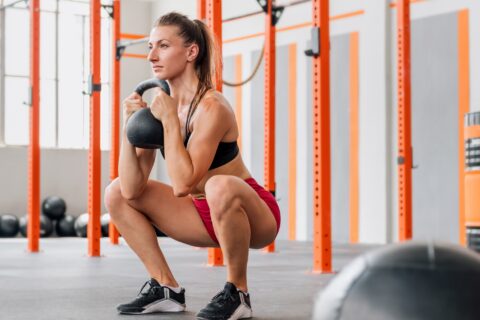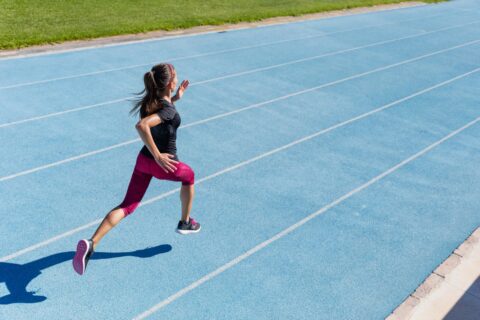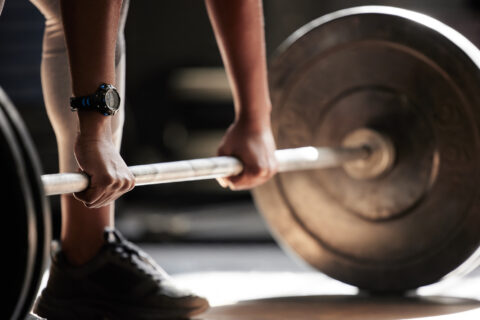A grim picture is frequently painted of our athletic potential after our mid-30s. It’s a canvas for a singular message: decline. We are told to expect a decline in muscle mass, a decline in maximal heart rate and oxygen delivery, a decline in stamina, and, of course, an ultimate decline in performance.
This decline has long been considered inevitable among athletes and researchers alike. Scientists studying the effects of aging arrived at this conclusion by comparing world records in a variety of events across all age categories. The result is a curvilinear relationship. We experience a gradual decline starting around the age of 35 that becomes much more precipitous around 70 years of age. [1,2]
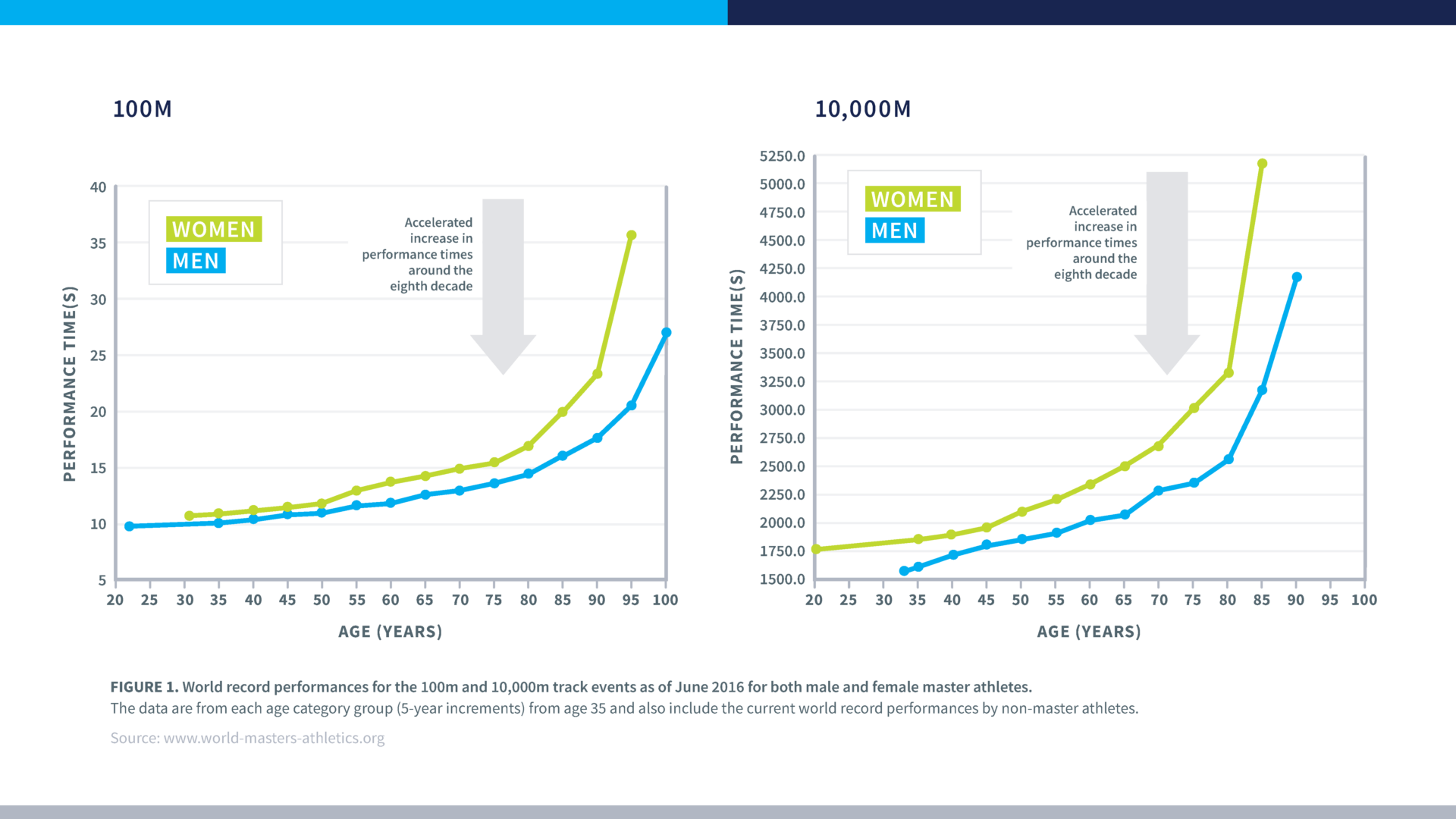
There’s a problem with this. Masters athletes seem to be disproving the science across most sports, and particularly endurance sports. Age group athletes are improving on world endurance records faster than their younger elite counterparts. [3] It’s not unheard of now for world championships to be won by athletes who are over the age of 40. Over half of the male finishers at the New York marathon are now above the age of 40. And tennis players like Serena Williams, Rafael Nadal, and Novak Djokovic have proven it’s possible to dominate the sport at an older age, raising the ceiling for generations to come.
“I know with a lot of people, they assume as their performance declines that [it] is a natural thing because, ‘I’m older, I’m getting slower, I’m going to get heavier.’ We just assume, because that’s what we’ve heard, that performance is going to decline,” says Ned Overend, a former world mountain bike champion.
Now in his late 60s, Overend admits that he doesn’t have the same sprint or ability to go hard off the gun he used to have, but that didn’t stop him from winning the prestigious Mt. Washington Hillclimb at 56.
Overend has earned a reputation for being a “freak of nature.” While he may not represent the typical masters athlete, it doesn’t stop him from making this recommendation to every athlete: “It’s really important to have an open attitude to the fact that you can slow aging with smart training.”
What past research got wrong on aging
The big issue with the older research showing our precipitous decline with age is that it was often cross-sectional, meaning current 80-year-olds were compared to current 50-year-olds and to current 20-year-olds. [2,4] The reason for doing this is understandable—it would take too long to conduct a study tracking current 20-year-old athletes over 60 years of life to see how age affects them.
However, this cross-sectional approach poses a serious issue. Both the understanding of how to train and cultural norms are very different from one generation to the next (e.g., when the 80-year-olds were 20, their reality looked very different from today’s). Comparing these athletes to the 20-year-olds of today is not a fair comparison. Many of the masters world records that were used to assess the decline with age are held by masters athletes who were not exceptional elite athletes in their youth, at least according to today’s standards. Sure, their performance probably declined over time, but they would be nowhere close to the best 20-somethings of today.
To take this a step further, it was not that long ago that high-level sports were thought to be only for youth, and most athletes quit in their 30s. As a result of this cultural norm, until recently, the pool of highly trained older athletes was very small. [3,4]
This led a 2016 review in the Journal of Aging and Physical Activity to find that much lower participation among masters may have produced an age-bias because higher participation drives better competition and performance. The recent sharp rise in participation of masters athletes would explain why their performance is improving at a faster rate than their younger counterparts. [4]
Along with lower participation, the review found that masters athletes tend to train less and at lower intensities due to factors like work and family commitments. As Overend has demonstrated, the review found that maintaining a high level of training can stave off many of the age-related decrements.
Both this review and several other studies concluded that what has been attributed to “natural aging” was more likely a result of decreased training volume and lower participation. [1–4,6]
All of this begs the important question —what changes are truly due to aging?
The true effects of age
A recent study reviewed the performances of Ed Whitlock, a multiple world record masters runners, spanning from the age of 65 to 86 and showed that his rate of decline increased substantially in his 80s. [5] While the decline is not as bad as we once feared, there still is a decline with age, and especially in our advanced years.
Decline in maximal heart rate
The most accepted age-related effect is a drop in maximal heart rate. [1] Training seems to be able to slow the decline, but not stop it. [7] “In general,” says Overend, “I cannot get my heart rate up as high as I could 10 years ago, and that’s pretty typical with older athletes.”
This fall-off in max heart rate also impacts the heart’s ability to deliver oxygenated blood to the working muscles. It would be reasonable to conclude that the lower max heart rate that comes with age will cause a decline in VO2max. [1,8] However, in 2008 a review titled Endurance Performance in Masters Athletes explored this effect, cited research showing that by maintaining training volume and intensity, much of the age-related decline can be mediated.
In fact, a 2019 study found that life-long endurance exercise could maintain a VO2max level that is well above the general population and also maintain most cardiovascular function with the exception of max heart rate. [9]
Decline in muscle mass
Perhaps the most cited age-related decline is a loss of muscle mass experienced by masters athletes. Interestingly, that loss has also been implicated in the decline in VO2max. [10]
The vast majority of age-related muscle loss is in anaerobic fast-twitch muscle fibers, which explains why many masters endurance athletes report both a loss in anaerobic capacity and peak power. [4,8]
Fortunately, this age-related loss of muscle mass doesn’t appear to be as inevitable as the decline in maximum heart rate. It’s more a proposition of “if you don’t use it, you will lose it.”
In fact, there’s a growing body of recent research showing that even adults over 80 can bring about muscle hypertrophy and activate “satellite cells” into fast-twitch fibers by engaging in a strength training program. [4,11,12]
A 2012 study in the European Journal of Applied Physiology looked at the effects of strength training in masters cyclists. It compared nine athletes around the age of 50 to eight athletes in their mid-20s. Both groups, neither of which had strength trained previously, were introduced to a three-week strength program. At the end of the intervention, the masters athletes saw a much greater improvement in muscle strength and the difference in cycling efficiency between the two groups was eliminated. In short, strength training helped both groups, but it benefited the masters athletes more. [13]
The study concluded by strongly recommending masters cyclist include strength training in their program. The loss of our stronger fast-twitch muscle fibers may not be as inevitable as originally thought.
Losses in motor unit function
One final known effect with age is something called motor unit remodeling. Our muscle fibers are connected to neurons which tell the fibers when to contract. Usually, multiple fibers are connected to a single neuron. This neuron and all of its attached fibers are called a motor unit. Throughout life, fibers frequently disconnect from their respective neurons and then are quickly reinnervated. Unfortunately, this process becomes less effective with age. [14,15]
When reinnervation is less effective, fibers often aren’t reattached to their original motor unit. This has two negative effects. First, the total number of motor units can decrease with age which can hamper our fine motor control. Second, the fibers are often reinnervated into a slow-twitch motor unit which can convert fast-twitch fibers into slow-twitch fibers. [14] This is particularly prevalent in female athletes who can really lose their explosive power. This makes it all the more important for masters women to do strength training.
Interestingly, it’s been theorized that denervated fibers produce more oxidative stress, which leads to improved antioxidant defenses in older athletes. That sounds like a positive, but it can actually hamper training because oxidative stress is needed to spark training adaptations. [15]
Does recovery get worse with age?
Overend reflects that training entails more “bad days” as he gets older, something he attributes to recovery.
Many masters athletes report that recovery is tougher after a hard workout and takes longer. Interestingly, the research doesn’t seem to back this up, suggesting that older and younger endurance athletes recover just as quickly. [16] Yet, it still takes longer for the masters to return to full function. [17]
In at least one study, they found that the biggest difference between masters and young athletes was the perception of fatigue and recovery. [16] Masters athletes just felt more fatigued and less recovered.
Unfortunately, another thing that affects recovery, particularly in long-time cyclists, is the accumulation of injury. According to Dr. Jason Glowney, a sports medicine physician at Boulder Biologics, arthritis in the knees, back issues, and other health concerns often impact an older athlete’s ability to train. Both Glowney and Overend agree that it is much harder for masters athletes to return from time off due to an injury. In other words, it’s not the physiology of accumulating so many years, it’s the wear and tear that comes with accumulating so many miles.
The benefits of life-long endurance training
In the evaluation of what aspects of performance decline with age, we can be forgiven for overlooking all of the things athletes gain with life-long training. In fact, a 2017 viewpoint in Gerontology lauded the greater health of competitive masters athletes and suggested they be studied as the models of successful aging. [18]
The research showing the benefits of training is very encouraging. Mitochondrial function was better in well-trained older athletes even when compared to recreationally active youth. [6] A key coenzyme in all living cells with respect to aging, NAD+ function was better maintained with both endurance and resistance training. [19] Lifelong endurance training was also associated with a greater overall oxidative capacity [20,21], and improved immune function. [22]
And while the benefits of strength training are well established, endurance training alone has also been shown to preserve muscle mass and lead to more successful motor unit remodeling with age. [23] Lifelong endurance athletes are much more successful than their sedentary counterparts at preserving their neuromuscular and motor unit function. [14,24,25]
Even better—at least for endurance athletes—there is something that actually improves with age. Relative to their VO2max, masters endurance athletes tend to have a better lactate threshold than young athletes. And while they do lose some of their type II anaerobic fibers, older endurance athletes see improvements in their type I aerobic fibers. They appear to have better capillary-to-fiber ratio and oxidative enzyme activity. They essentially become pure aerobic animals, probably due to years of endurance training. [1]
These enhanced aerobic capacities appear to allow older highly trained athletes to remain competitive even if they don’t have that big anaerobic burst they used to have.
“We have a Tuesday night group ride here in Durango with a lot of fast kids from Fort Lewis College and a lot of local mountain bike and road pros,” says Overend, who still joins in. “I can get in a break, and indeed, get in many breaks. . . . I can make it down to a small group, but then when the guys start attacking at the end, I can get dropped.”
References
[1] Reaburn P., Dascombe B. Endurance Performance in Masters Athletes. Eur Rev Aging Phys A 2008;5:31–42.
[2] Lazarus N.R., Harridge S.D.R. Declining Performance of Master Athletes: Silhouettes of the Trajectory of Healthy Human Ageing? J Physiology 2017;595:2941–8.
[3] Lepers R., Stapley P.J. Master Athletes Are Extending the Limits of Human Endurance. Front Physiol 2016;7:613.
[4] Borges N., Reaburn P., Driller M., Argus C. Age-Related Changes in Performance and Recovery Kinetics in Masters Athletes: A Narrative Review. J Aging Phys Activ 2016;24:149–57.
[5] Lepers R., Cattagni T. Age-Related Decline in Endurance Running Performance—An Example of a Multiple World Records Holder. Appl Physiology Nutrition Metabolism 2018;43:98–100.
[6] Joanisse S., Ashcroft S., Wilkinson D.J., Pollock R.D., O’Brien K.A., Phillips B.E., et al. High Levels of Physical Activity in Later Life are Associated with Enhanced Markers of Mitochondrial Metabolism. Journals Gerontology Ser 2020;75:1481–7.
[7] Ozemek C., Whaley M.H., Finch W.H., Kaminsky L.A. High Cardiorespiratory Fitness Levels Slow the Decline in Peak Heart Rate with Age. Medicine Sci Sports Exerc 2016;48:73–81.
[8] Peiffer J.J., Abbiss C.R., Chapman D., Laursen P.B., Parker D.L. Physiological Characteristics of Masters-Level Cyclists. J Strength Cond Res 2008;22:1434–40.
[9] Valenzuela P.L., Maffiuletti N.A., Joyner M.J., Lucia A., Lepers R. Lifelong Endurance Exercise as a Countermeasure Against Age-Related VO2max Decline: Physiological Overview and Insights from Masters Athletes. Sports Med 2020;50:703–16.
[10] Fleg J.L., Lakatta E.G. Role of Muscle Loss in the Age-Associated Reduction in VO2max. J Appl Physiol 1988;65:1147–51.
[11] Kneffel Z., Murlasits Z., Reed J., Krieger J. A Meta-Regression of the Effects of Resistance Training Frequency on Muscular Strength and Hypertrophy in Adults over 60 Years of Age. J Sport Sci 2021;39:351–8.
[12] Grgic J., Garofolini A., Orazem J., Sabol F., Schoenfeld B.J., Pedisic Z. Effects of Resistance Training on Muscle Size and Strength in Very Elderly Adults: A Systematic Review and Meta-Analysis of Randomized Controlled Trials. Sports Med 2020;50:1983–99.
[13] Louis J., Hausswirth C., Easthope C., Brisswalter J. Strength Training Improves Cycling Efficiency in Master Endurance Athletes. Eur J Appl Physiol 2012;112:631–40.
[14] Piasecki J., Inns T.B., Bass J.J., Scott R., Stashuk D.W., Phillips B.E., et al. Influence of Sex on the Age‐Related Adaptations of Neuromuscular Function and Motor Unit Properties in Elite Masters Athletes. J Physiology 2021;599:193–205.
[15] Jackson M.J. On the Mechanisms Underlying Attenuated Redox Responses to Exercise in Older Individuals: A Hypothesis. Free Radical Bio Med 2020;161:326–38.
[16] Borges N.R., Reaburn P.R., Doering T.M., Argus C.K., Driller M.W. Age-Related Changes in Physical and Perceptual Markers of Recovery Following High-Ontensity Interval Cycle Exercise. Exp Aging Res 2018;44:1–12.
[17] Easthope C.S., Hausswirth C., Louis J., Lepers R., Vercruyssen F., Brisswalter J. Effects of a Trail Running Competition on Muscular Performance and Efficiency in Well-Trained Young and Master Athletes. Eur J Appl Physiol 2010;110:1107–16.
[18] Tanaka H. Aging of Competitive Athletes. Gerontology 2017;63:488–94. .
[19] Guia R.M. de, Agerholm M., Nielsen T.S., Consitt L.A., Søgaard D., Helge J.W., et al. Aerobic and Resistance Exercise Training Reverses Age‐Dependent Decline in NAD+ Salvage Capacity in Human Skeletal Muscle. Physiological Reports 2019;7:e14139.
[20] Skoglund E., Stål P., Lundberg T.R., Gustafsson T., Tesch P.A., Thornell L.E. Skeletal Muscle Morphology, Satellite Cells, and Oxidative Profile in Relation to Physical Function and Lifelong Endurance Training in Very Old Men. J Appl Physiol 2023;134:264–75.
[21] Ringholm S., Gudiksen A., Halling J.F., Qoqaj A., Rasmussen P.M., Prats C, et al. Impact of Aging and Lifelong Exercise Training on Mitochondrial Function and Network Connectivity in Human Skeletal Muscle. Journals Gerontology Ser 2022;78:373–83.
[22] Perkins R.K., Lavin K.M., Raue U., Jemiolo B., Trappe S.W., Trappe T.A. Effects of Aging and Lifelong Aerobic Exercise on Expression of Innate Immune Components in Human Skeletal Muscle. J Appl Physiol 2020;129:1483–92.
[23] Ozaki H., Loenneke J., Thiebaud R., Abe T. Cycle Training Induces Muscle Hypertrophy and Strength Gain: Strategies and Mechanisms. Acta Physiol Hung 2015;102:1–22.
[24] Laurin J.L., Reid J.R., Lawrence M.M., Miller B.F. Long-Term Aerobic Exercise Preserves Muscle Mass and Function with Age. Curr Opin Physiology 2019;10:70–4.
[25] Bieuzen F., Hausswirth C., Louis J., Brisswalter J. Age-Related Changes in Neuromuscular Function and Performance Following a High-Intensity Intermittent Task in Endurance-Trained Men. Gerontology 2010;56:66–72.

